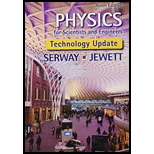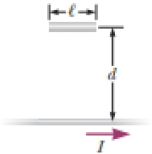
A thin wire ℓ = 30.0 cm long is held parallel to and d = 80.0 cm above a long, thin wire carrying I = 200 A and fixed in position (Fig. P30.47). The 30.0-cm wire is released at the instant t = 0 and falls, remaining parallel to the current-carrying wire as it falls. Assume the falling wire accelerates at 9.80 m/s2. (a) Derive an equation for the emf induced in it as a function of time. (b) What is the minimum value of the emf? (c) What is the maximum value? (d) What is the induced emf 0.300 s after the wire is released?
Figure P30.47

(a)
Answer to Problem 31.78AP
Explanation of Solution
Given info: Length of wire is
The speed of the wire according to Newton’s law of motion can be given as,
Here,
Substitute
The distance covered by the wire can be given as,
Here,
Substitute
The total distance covered by wire can be given as,
Here,
Substitute
The magnetic field at a distance
Here,
The emf induced in the wire can be given as,
Here,
Substitute
Substitute
Conclusion:
Therefore, the equation for emf induced in the wire as function of time is
(b)
Answer to Problem 31.78AP
Explanation of Solution
Given info: Length of wire is
The expression for emf can be given as in equation (1),
At
Conclusion:
Therefore, the minimum value of emf is
(c)
Answer to Problem 31.78AP
Explanation of Solution
Given info: Length of wire is
The expression for emf can be given as in equation (1),
From the above equation, at
Conclusion:
Therefore, the minimum value of emf is
(d)
Answer to Problem 31.78AP
Explanation of Solution
Given info: Length of wire is
The expression for emf can be given as in equation (1),
Substitute
Conclusion:
Therefore, the induced emf
Want to see more full solutions like this?
Chapter 31 Solutions
Bundle: Physics for Scientists and Engineers, Technology Update, 9th Loose-leaf Version + WebAssign Printed Access Card, Multi-Term
- 6.0 A current flows through a 5.0 m thin and straightconductor wire. What is the magnitude of themagnetic field (in unit of nT) at a distance above4.0 m from the midpoint of the wire.(Take µ0 =4πx10−7 T.m/A )arrow_forwardIn earlier times when many households received nondigital television signals from an antenna, the lead-in wires from the antenna were often constructed in the form of two paral- lel wires (Fig. P31.50). The two wires carry currents of equal magnitude in opposite directions. The center-to-center separation of the wires is w, and a is their radius. Assume w is large enough compared with a that the wires carry the current uniformly distributed over their surfaces and negli- gible magnetic field exists inside the wires. (a) Why does this configuration of conductors have an inductance? (b) What TV antenna TV set Figure P31.50 constitutes the flux loop for this configuration? (c) Show that the inductance of a length x of this type of lead-in is w - a L In aarrow_forwardA very long solenoid of circular cross section with radius a= 5.40 cm has n= 62.0 turns/cm of wire. An electron is sitting outside the solenoid, at a distance r= 5.90 cm from the solenoid axis. What is the magnitude of the force on the electron while the current in the solenoid is ramped up at a rate of 28.0 Amps/s?arrow_forward
- Rail guns have been suggested for launching projectiles into space without chemical rockets. A tabletop model rail gun (as shown) consists of two long, parallel, horizontal rails ℓ = 3.50 cm apart, bridged by a bar of mass m = 3.00 g that is free to slide without friction. The rails and bar have low electric resistance, and the current is limited to a constant I = 24.0 A by a power supply that is far to the left of the figure, so it has no magnetic effect on the bar. As shown the bar at rest at the midpoint of the rails at the moment the current is established. We wish to find the speed with which the bar leaves the rails after being released from the midpoint of the rails. (a) Find the magnitude of the magnetic field at a distance of 1.75 cm from a single long wire carrying a current of 2.40 A. (b) For purposes of evaluating the magnetic field, model the rails as infinitely long. Using the result of part (a), find the magnitude and direction of the magnetic field at the midpoint of…arrow_forwardIn the figure below, the two ends of a U-shaped wire of mass m = 7.00 g and length L = 17.0 cm are immersed in mercury (which is a conductor). The wire is in a uniform field of magnitude B = 0.0860 T. A switch (unshown) is rapidly closed and then reopened, sending a pulse of current through the wire, which causes the wire to jump upward. If jump height h = 4.00 m, how much charge was in the pulse? Assume that the duration of the pulse is much less than the time of flight. Hg. Number i X L X Units X Marrow_forwardA conducting rod of length ℓ moves on two horizontal, frictionless rails as shown inFigure P31.26. If a constant force of 1.00 N moves the bar at 2.00 m/s through amagnetic field B that is directed into the page (a) what is the current through the 8.00-Ω resistor R? (b) What is the rate at which energy is delivered to the resistor? (c) Whatis the mechanical power delivered by the force Fapp?arrow_forward
- A wire of nonmagnetic material, with radius R, carries current uniformly distributed over its cross section. The total current carried by the wire is I. Show that the magnetic energy per unit length inside the wire is μ0I2/16π.arrow_forwardA strip of metal (made from copper, with 8.47 x 1028 charge carriers/m³) is placed in a uniform magnetic field oriented perpendicular to the strip with magnitude 0.205 T. A current i = 6.18 A is passed through the strip, giving rise to a Hall potential across its thickness of 0.481 mm. What is the magnitude of the Hall potential that arises? i Varrow_forward. A uniform magnetic field is directed normal to the plane of a wire that has been formed into 6a circular ring of radius, r = 3.1 cm. The magnetic field is uniform in space, but changeswith time. The resistance of this ring is R = 2.0 Ω. A steady current of i = 2.5 mA flowsthrough the wire. How fast is the magnetic field changing?arrow_forward
- 5. A schematic drawing of a rail gun. Projectile P sits between two wide rails of circular cross section; a source of current sends current through the rails and through the (conducting) projectile (a fuse is not used). (a) Let d be the distance between the rails, r the radius of each rail, and i the current. Find the expression for force on the along the rails and is given approximately Source L DV If the projectile starts from the left end of the rails at rest, find the speed v at which it is expelled at the right. Assume that i =525 kA, d=9.7 mm, r= 8.2 cm, L=5.4 m, and the projectile mass is 12 g.arrow_forwardA hollow copper tube carries a current along its length. Why is B = 0 inside the tube? Is B nonzero outside the tube?arrow_forwardA metal strip 5.00 cm long, 0.800 cm wide, and 0.700 mm thick moves with constant velocity through a uniform magnetic field B = 1.00 T directed perpendicular to the strip, as shown in the figure. A potential difference of 4.70 mV is measured between points x and y across the width of the strip. Calculate the speed v (in m/s). Hint: How fast are the electrons moving through the magnetic field? Give your answer as only the numerical value in the SI units specified. e is interpreted as x10^ for use with large or small values; 1.01e2 is interpreted as 1.01 x 102. Barrow_forward
 Physics for Scientists and Engineers: Foundations...PhysicsISBN:9781133939146Author:Katz, Debora M.Publisher:Cengage Learning
Physics for Scientists and Engineers: Foundations...PhysicsISBN:9781133939146Author:Katz, Debora M.Publisher:Cengage Learning
